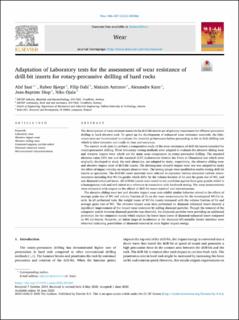| dc.contributor.author | Saai, Afaf | |
| dc.contributor.author | Bjørge, Ruben | |
| dc.contributor.author | Dahl, Filip Erik Bo | |
| dc.contributor.author | Antonov, Maksim | |
| dc.contributor.author | Kane, Pascal-Alexandre | |
| dc.contributor.author | Diop, Jean-Baptiste | |
| dc.contributor.author | Ojala, Niko | |
| dc.date.accessioned | 2022-03-02T08:42:15Z | |
| dc.date.available | 2022-03-02T08:42:15Z | |
| dc.date.created | 2020-06-02T11:23:14Z | |
| dc.date.issued | 2020 | |
| dc.identifier.citation | Wear. 2020, 456-457 . | en_US |
| dc.identifier.issn | 0043-1648 | |
| dc.identifier.uri | https://hdl.handle.net/11250/2982302 | |
| dc.description.abstract | The development of wear resistant materials for drill-bit inserts are of primary importance for efficient percussive drilling in hard abrasive rock. To speed up the development of enhanced wear resistance materials, the laboratory tests are fundamental to evaluate the material performance before proceeding to the in-field drilling test which is labor-intensive and costly in time and resources. The current work aims to perform a comparative study of the wear resistances of drill-bit inserts intended for rotary-percussive drilling. Three laboratory testing methods were adapted to evaluate the abrasive sliding wear and abrasive impact wear which are the main wear components in rotary-percussive drilling. The standard abrasion value (AV) test and the standard LCPC (Laboratoire Central des Ponts et Chaussées) test which were originally developed to study the rock abrasivity, are adapted to study, respectively, the abrasive sliding wear and abrasive impact wear of drill-bit inserts. The disintegrator abrasive impact wear test was adapted to study the effect of impact velocity on impact abrasive wear. The testing setups were modified to enable testing drill-bit inserts as specimens. The drill-bit insert materials were selected to represent various cemented carbide microstructures including five WC-Co grades which differ by the volume fraction of Co and the grain size of WC, and one diamond enhanced insert. All drill-bit inserts were tested in dry condition against Kuru grey granite which is a homogenous rock and well suited as a reference in connection with hard rock testing. The wear measurements were evaluated with respect to the effects of drill-bit insert material and microstructure. The abrasive sliding wear test and abrasive impact wear tests exhibit similar behavior related to the effects of average grain size of WC and volume fraction of Co on the wear measurements for the investigated WC-Co inserts. In all performed tests, the weight losses of WC-Co inserts increased with the volume fraction of Co and average grain size of WC. The abrasive impact wear tests performed on diamond enhanced insert showed a significant improvement of the impact wear resistance by adding diamond particles. Though the removal of the composite matrix between diamond particles was observed, the diamonds particles were providing an additional protection for the composite matrix which explain the lower mass losses of diamond enhanced insert compared to WC-Co inserts. However, an initial stage of decohesion at the diamond/WC-metallic binder interface were observed indicating possibilities of diamond removal at more higher impact energy. | en_US |
| dc.language.iso | eng | en_US |
| dc.publisher | Elsevier | en_US |
| dc.rights | Navngivelse 4.0 Internasjonal | * |
| dc.rights.uri | http://creativecommons.org/licenses/by/4.0/deed.no | * |
| dc.subject | Microstructural characterizations | en_US |
| dc.subject | Diamond enhanced inserts | en_US |
| dc.subject | Cemented tungsten carbide-cobalt | en_US |
| dc.subject | Abrasive sliding wear | en_US |
| dc.subject | Abrasive impact wear | en_US |
| dc.subject | Laboratory tests | en_US |
| dc.title | Adaptation of Laboratory tests for the assessment of wear resistance of drill-bit inserts for rotarypercussive drilling of hard rocks | en_US |
| dc.type | Peer reviewed | en_US |
| dc.type | Journal article | en_US |
| dc.description.version | publishedVersion | en_US |
| dc.rights.holder | © 2020 The Authors. Published by Elsevier B.V. This is an open access article under the CC BY license | en_US |
| dc.source.pagenumber | 10 | en_US |
| dc.source.volume | 456-457 | en_US |
| dc.source.journal | Wear | en_US |
| dc.identifier.doi | 10.1016/j.wear.2020.203366 | |
| dc.identifier.cristin | 1813459 | |
| dc.relation.project | Norges forskningsråd: 254984 | en_US |
| dc.source.articlenumber | 203366 | en_US |
| cristin.ispublished | true | |
| cristin.fulltext | original | |
| cristin.qualitycode | 1 | |

